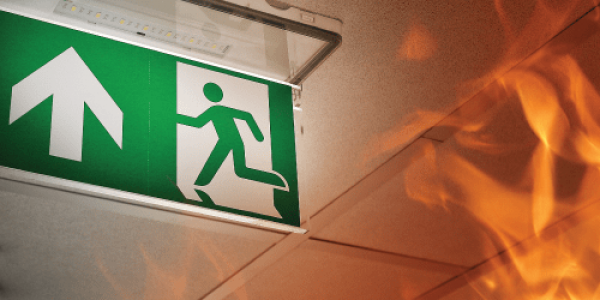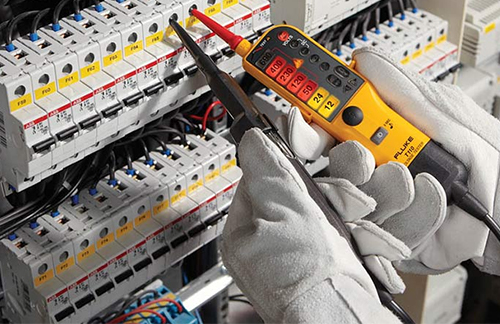What causes electrical fires within the workplace?

Electrical fires are common in both workplace and residential settings. According to data from Home Office Statistics, more than 16,000 non-residential fires are reported each year in the UK despite the fact that fire safety regulations have tightened, and a large proportion of these are found to take place at work and as a consequence, there were 318 fire-related fatalities during period 2018/19. It was estimated that fires cost the UK economy £8.3 billion!
What is an electrical fire?
An electrical fire is a failure or malfunction within the electrical components of equipment or machinery can cause electrical fires. Electrical fires originate in electric wires, cables, circuit breakers, and within electrical components. Fires start in electrical panels from overloaded circuits or the age of the panel. The panel and circuits become overloaded when the distribution of electricity is inadequate. Occasionally, lighting equipment acts as a source of heat that is too close to easily combustible materials.
What are the common causes of electrical fires?
In 2018, our global consumption of energy was 62 billion kWh per day. We rely heavily on electricity to power our businesses, homes, and for a growing number of electric cars. Do not assume your electrical systems are functioning properly because they work on a day-to-day basis with no issues. Electrical systems pose an ongoing fire risk. Understanding common causes of electrical fires and following preventive measures to maintain your electrical systems will mitigate your chance of a fire.
Electrical Fires cost the UK economy £8.3 billion
Poor electrical installation maintenance
Poor maintenance is the leading cause of electrical fires. Performing regular maintenance on electrical panels (distribution) will reduce the risk of fire. Maintenance includes an inspection and test of the electrical installation, circuit breakers, wiring integrity etc. known as a “Electrical Inspection Condition Report”, commonly referred to as a EICR certificate. This inspection will identify faults and observations including but not limited to, correct cable size and breaker rating, loose terminals, damaged accessories, and equipment all of which can lead to a fire.
Aging equipment and faulty appliances
Aging equipment and faulty appliances cause a staggering number of electrical fires. According to Home Office Statistics, 3,667 faulty appliances (25.9%) were the sole cause of fire-related incidents in the workplace. In order to prevent this, it is important to have a qualified/competent company/person to regularly PAT test your equipment to ensure it is still safe to use. It is also important your staff are vigilant and keep an extra eye out for any signs of damaged equipment, cables, and plugs.
Keeping up with healthy & safety and regulations
Aging In this current “blame culture society” it is vitally important to protect your business from any unnecessary attention. Claims for breaches under the headings of health and safety and regulations can be extremely costly and even the potentially of imprisonment. By complying with the Electricity at Work Act 1974 and the Electricity at Work Regulations 1989, regular electrical inspection and testing of your installation and equipment will demonstrate, “so far as is reasonably practicable” to the Authorities, you have made all efforts to maintain the electrical installation and the equipment operated and used by your employees. In addition, Insurers will normally want evidence of an inspection regime to support that the installation is being maintained
Electrical panels and circuit breakers
A circuit breaker protects an electrical circuit from damage by automatically shutting off power to the circuit. Breakers trip because of overloaded circuits, power surges or spikes, a short circuit, and ground fault. If the circuit breaker fails, it can damage appliances or equipment on the circuit or lead to a fire. Keeping your electrical panel and circuit breakers up to date reduces the failure rate. Some of the warning signs that you need to replace circuits is a burning smell in the electrical panel, the breakers trip frequently or will not stay reset, physical damage, and old age.
How to put out an electrical fire
A There are several classes of fires. In the case of an electrical fire, do not try putting it out with water. Trying to put out the fire with water will only worsen the situation and puts you and others in more danger. Water conducts electricity and putting water on or near a power source can give you a severe electrical shock. It might even make the fire worse.
Two options to put out an electrical fire are a handheld fire extinguisher or an automatic fire suppression system. If suppressing the fire with a handheld fire extinguisher, then you must use a CO2 or Powder extinguisher. The drawback of using a fire extinguisher is that a person must be present when the fire starts. A person will need to grab the fire extinguisher and release the fire suppression agent from the extinguisher.
Original source of information: GOV UK Fire Statistics Monitor
How to put out an electrical fire?
There are several classes of fires. In the case of an electrical fire, do not try putting it out with water. Trying to put out the fire with water will only worsen the situation and puts you and others in more danger. Water conducts electricity and putting water on or near a power source can give you a severe electrical shock. It might even make the fire worse.
Two options to put out an electrical fire are a handheld fire extinguisher or an automatic fire suppression system. If suppressing the fire with a handheld fire extinguisher, then you must use a CO2 or Powder extinguisher. The drawback of using a fire extinguisher is that a person must be present when the fire starts. A person will need to grab the fire extinguisher and release the fire suppression agent from the extinguisher.
Original source of information: GOV UK Fire Statistics Monitor
Contact us today for support with your electrical compliance requirements

Plant and Safety Ltd are a national NICEIC Approved Contractor for wide range of Electrical Compliance and Electrical Testing Services, including but not limited to Fixed Wire Testing (EICR). Click here to learn more about our Electrical Testing Services, or contact us using the phone number and email address below.
About Plant and Safety Limited

Plant and Safety Limited are the UK trading business for the LB International Group, which operates from the Middle East, and Africa. Plant and Safety are national providers of Inspection, Testing, Certification, Lifting Equipment, and Training Services on equipment within the work place. This includes electrical Equipment, lifting equipment, work equipment, plant equipment, and access equipment.
